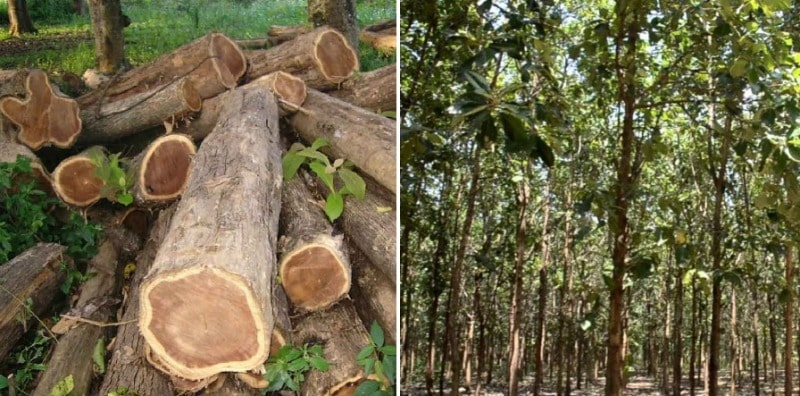Description

Copyright infringement not intended
Picture Courtesy: https://gkfagroforestry.in/teak-cultivation/
Context: India is one of the largest producers of teak wood in the world, but many teak plantations are underperforming due to a number of factors, including the use of misleading advertisements, a lack of thinning practices, and the absence of comprehensive best practices for cultivation.
Some of the major concerns that are harming India's teak plantations
- Misleading claims and lack of knowledge: Farmers are often lured by unrealistic promises of high returns from teak plantations, but lack the knowledge and guidance on proper cultivation practices. This leads to disappointment and poor yields.
- Improper spacing and thinning: Teak trees need proper spacing and thinning to grow well. However, many farmers plant them too close together and neglect thinning, resulting in stunted growth and lower-quality wood.
- Absence of comprehensive best practices: There's a lack of readily available information and manuals on best practices for teak cultivation in India. Farmers often rely on unreliable sources or guesswork, leading to suboptimal results.
- Deceptive marketing and fraudulent practices: Some private entities promote misleading schemes and sell poor-quality planting material, further disadvantageous farmers.
- Challenges in marketing and fair pricing: Despite being a major teak producer, India imports a significant amount of teak due to complex regulations and a lack of effective marketing channels. Farmers often struggle to get fair prices for their trees.
Recommendations for improvement
- Sensitize farmers: Educate farmers about realistic expectations, proper cultivation techniques, and the long-term commitment involved in teak plantations.
- Promote best practices: Develop and disseminate comprehensive manuals and guidelines on teak cultivation, including spacing, thinning, pruning, and soil management.
- Address misinformation: Counter misleading claims and promote reliable information sources to empower farmers.
- Ensure quality planting material: Encourage the use of certified planting material from reputable sources to ensure good quality trees.
- Improve marketing and pricing: Facilitate transparent and efficient marketing channels for farmers to get fair prices for their teak wood.
- Provide support and extension services: Offer technical assistance and extension services to farmers throughout the teak cultivation process.
Teak Production in India
- Teak (Tectona grandis) is one of the most valuable hardwood timber trees in the world. It is native to India and Southeast Asia, where it grows naturally in the peninsular region below 24°N latitude. Teak is also widely cultivated in plantations across tropical and subtropical regions, especially in Africa and Latin America.
- Teak wood is highly prized for its durability, strength, stability, workability and aesthetic qualities. It is used for making furniture, doors, windows, ships, boats, flooring, wall panels and various other products.
- Teak wood has a golden-brown colour that darkens with age and exposure to sunlight. It has a straight grain and a coarse texture. It contains natural oils that make it resistant to termites, fungi, rot and fire.

History of Teak Production in India
- Teak has a long history of use and cultivation in India. It is mentioned in ancient Sanskrit texts as "saka" or "sagwan". It was also known as "tegon" or "teku" by the local tribes.
- Teak was used for building temples, palaces, forts, ships and bridges by various dynasties and empires in India. It was also exported to other countries such as China, Persia, Arabia and Europe.
- The British colonial rulers recognized the value of teak and established teak plantations in India in the 19th century. They also imposed strict regulations on the felling and export of teak from natural forests. They developed scientific methods of silviculture and management of teak plantations. They also introduced improved varieties of teak from other countries such as Burma, Java and Thailand.
- After independence, India continued to expand its teak plantations and conserve its natural teak forests. India also became a major exporter of teak wood to the international market. Today, India is one of the world's largest producers and consumers of teak wood.
Importance of Teak Production in India
- Livelihood and Economic Impact: Teak cultivation, harvesting, processing, and marketing provide livelihoods for millions of individuals, including farmers, forest dwellers, workers, and traders. The teak industry contributes significantly to the income of these stakeholders, supporting rural economies and fostering economic growth.
- Government Revenue Generation: Teak production generates revenue for the government through taxes and royalties. This income contributes to public funds, which can be reinvested in forestry management, conservation efforts, and social development projects.
- Ecological and Environmental Benefits: Teak plantations play a crucial role in soil conservation, helping prevent erosion and maintaining soil quality. The roots of teak trees aid in water regulation, and teak plantations contribute to carbon sequestration, helping mitigate climate change. Teak forests serve as habitats for diverse wildlife species, contributing to biodiversity conservation. Additionally, teak plantations provide a source of non-timber forest products, including honey, fruits, nuts, and medicinal plants.
- Social and Cultural Values: Teak holds cultural and social significance in India, symbolizing prestige and prosperity for many communities. The wood is associated with religious and spiritual beliefs and practices, and it is often used in rituals, ceremonies, and festivals by various religions and ethnic groups. The cultural importance of teak contributes to its preservation and sustainable management, fostering a connection between communities and their natural resources.
|
Current Status
●India was once the world's leading producer of teak, boasting vast natural teak forests across the central and southern regions. Uncontrolled deforestation and increasing demand led to a decline in natural teak reserves. The government imposed bans on clear-felling in the 1980s, promoting plantation-based teak production.
●Today, India is no longer a major teak producer, relying on imports to meet domestic needs. While plantations contribute to some production, they haven't fully bridged the gap.
●Madhya Pradesh, Maharashtra, Karnataka, Kerala, and Tamil Nadu are the leading states in teak production, contributing a significant share to the national output.
|
Teak production in India faces several challenges such as:
- Declining Productivity and Quality: Poor site selection, inadequate planting material, improper silvicultural practices, pests, diseases, climate change, and fire contribute to a decline in the productivity and quality of teak plantations.
- Competition from Other Timber Species: Teak faces increasing competition from other timber species such as eucalyptus, acacia, poplar, and bamboo. These species often exhibit faster growth, higher yield, and lower cultivation costs.
- Land Availability Constraints: The availability of suitable land for teak plantations is shrinking due to urbanization, industrialization, agricultural expansion, and infrastructure development.
- Rising Costs: The cultivation, harvesting, and processing of teak face rising costs associated with labour, inputs, and transportation, which may affect the economic viability of teak production.
- Stringent Regulations: Stringent regulations and policies on the felling and export of teak from natural forests may pose challenges in terms of compliance and the ability to meet market demand.
- Lack of Awareness and Knowledge: There is a lack of awareness and knowledge among farmers, forest dwellers, workers, and traders about the benefits and best practices of teak production. This may lead to suboptimal management practices and reduced productivity.
- Low-Value Addition and Innovation: The processing and marketing of teak wood and products suffer from low-value addition and innovation. This limits the scope for diversification and development of high-value teak-based products.
Way Forward
- Increasing Demand for Teak Wood: The high quality, durability, beauty, and prestige associated with teak wood contribute to a growing demand both in domestic and international markets. This demand provides opportunities for expanding teak cultivation and trade.
- Improved Varieties of Teak: The availability of improved teak varieties with faster growth, higher yield, and disease resistance offers opportunities to enhance productivity and meet market demands more efficiently.
- Advanced Technologies: The use of advanced technologies such as tissue culture, genetic engineering, remote sensing, and GIS can significantly enhance the productivity and quality of teak plantations. These technologies offer opportunities for efficient management and monitoring.
- Government and Private Sector Support: Various schemes and incentives from both the government and private sector support the development and promotion of teak production. These initiatives can encourage investment, research, and sustainable practices in the teak industry.
- Information Exchange Platforms: The availability of platforms and networks facilitates the exchange of information, knowledge, skills, and resources among stakeholders involved in teak production. This collaborative environment can foster innovation and best practices.
- Diversification into Value-Added Products: Teak wood provides opportunities for the production of various value-added products, including biofuel, charcoal, paper pulp, plywood, and veneer. Diversifying into these products can enhance the economic viability of teak cultivation.
- Environmental and Agroforestry Benefits: Teak plantations offer environmental benefits such as carbon sequestration, biodiversity conservation, and soil conservation. These aspects contribute to the potential for teak to be integrated into agroforestry systems.
- International Cooperation: Collaboration with international markets and organizations can open up opportunities for export and partnerships, contributing to the global reputation and market presence of Indian teak.

Conclusion
- Teak production in India is not only an economic endeavour but also a reflection of the country's cultural heritage, environmental responsibility, and the dynamic interplay between tradition and modernity in the forestry sector. The challenges and opportunities in teak production require a holistic and collaborative approach to ensure the long-term sustainability of this valuable resource.
|
PRACTICE QUESTION
Q. In regions with high poverty rates and a dependence on forestry for livelihoods, how can sustainable forestry practices be effectively implemented without jeopardizing immediate economic needs? Can this trade-off be overcome, and if so, what innovative solutions or social programs can be employed?
|
















